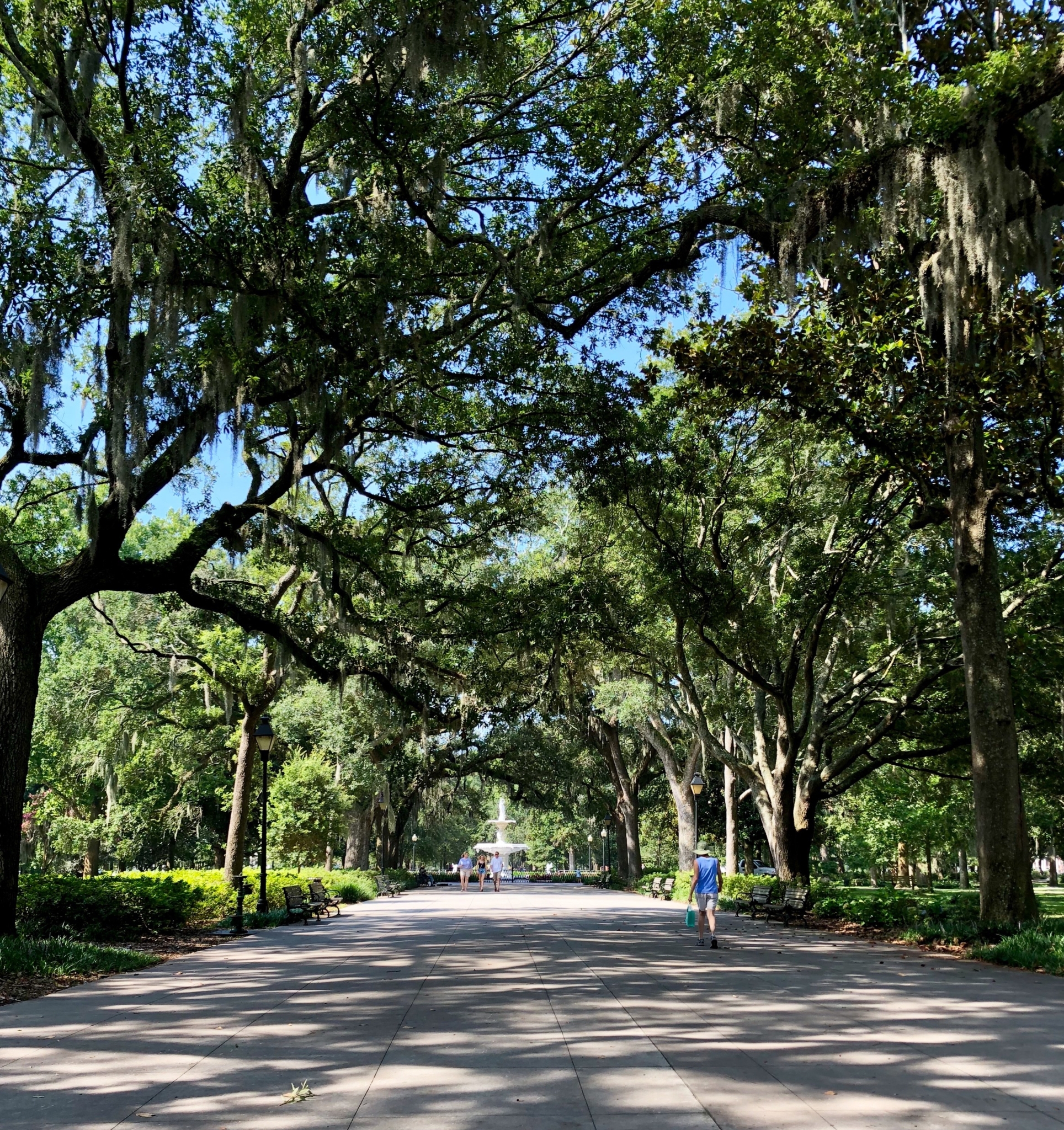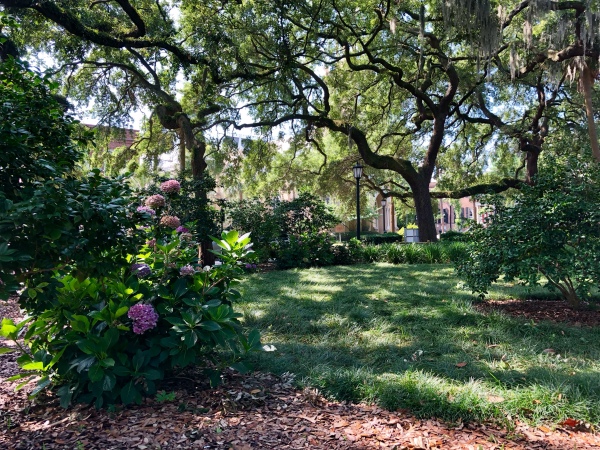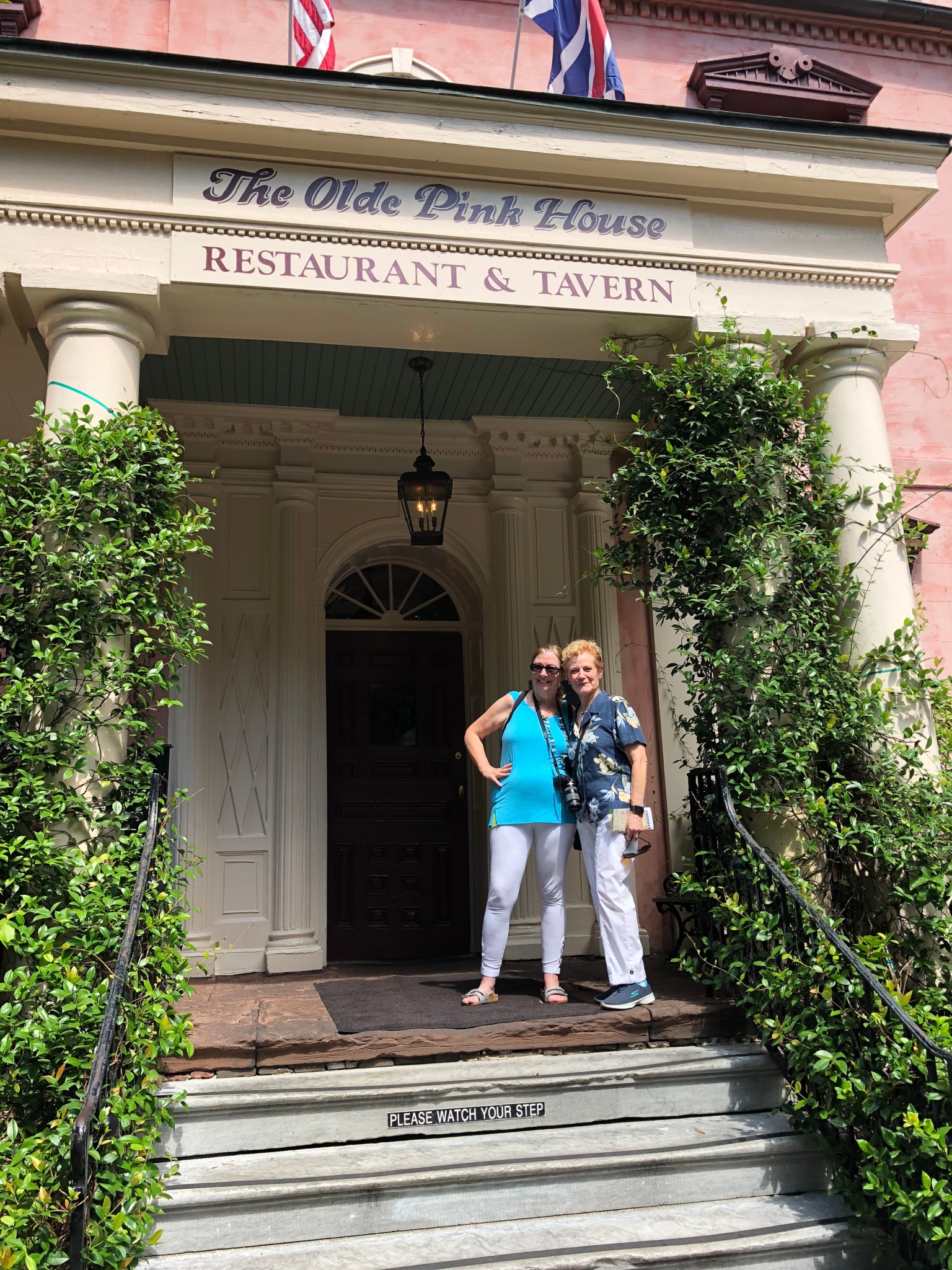
This post has been a difficult one to write. That fact that it has taken me six months to write it should be a clear indication of that. I visited Savannah, Georgia, the end of June intending a post on the squares in the historic district, providing a little background context on the Oglethorpe plan, listing some of the most frequently used plants, and considering the importance of green spaces in urban settings. From the outset, though, I lost focus—or more accurately, never found focus. The importance of green spaces in urban settings took me to parks planning in Birmingham and to the benefits of trees in maintaining air quality. Then I read a report on the global climate effect of deforestation in the Amazon, of the loss of an estimated 18 million acres a year by the United Nations’ Food and Agricultural Organization (FAO) (htps://livescience.com/27692-deforetation.html). Suddenly, I found myself far, far afield, transported from a steamy but shaded public square in a Southern city to clear-cut island in the midst of a South American rainforest.
Former Speaker of the House of Representatives Tip O’Neill might have advised “all politics is local,” but air quality is global and for a period of time I could not separate green spaces of the city from the vanishing tropical forests of the world. Eventually, though, I looked again through my Savannah photos, did a route recalculation of my mental GPS, and got back on track for my original intent—then the “Fourth National Climate Assessment Volume II: Impacts, Risks, and Adaptation in the United States” (https://nca2018.globalchange.gov) was released. The forecast for increased risks to air quality and for extreme climate events, including drier summers and wetter winters for Alabama, did not bode well for local farmers or gardeners—neither did it bode well for my keeping focus and avoiding an environmental detour from Savannah’s squares as historic garden sites.
When General James Oglethorpe laid out Savannah’s first four squares in 1733, though, his focus was neither on clean air or looming environmental threats. And if this post was ever going to be written, neither could mine. I had to once again recalculate and narrow my focus from global green spaces to these particular green spaces. They were part of a grand city plan that addressed housing, space for municipal buildings, and common spaces with characteristic 18th-century symmetry. Twenty-two of the original 24 planned squares still exist, including those first four, Johnson, Wright, Ellis, and Telfair, and two more laid out by Oglethorpe in 1734 and 1742. The dot “fare free visitor transportation” map for the historic district, as well as providing a great service for tourists, provides a good illustration of the scheme.


The last of the squares planned by Oglethorpe, which he called Upper New Square, was eventually renamed for him. His statue, however, sits in the center of Chippewa Square, which may be better known outside of Georgia for being the site of park bench scene in the film Forrest Gump (1994). Southern live oak, or Quercus virginiana, dominates the tree population of this and the other heavily canopied squares. Camellia (Camellia japonica) is ever present as well, as can been seen in the first photo below of Wright Square. The second photo of Wright Square, with the plaque memorializing Tomochichi, friend of Oglethorpe, Chief of the Yamacraw Indians, and mediator between his people and the English during the settlement of Georgia, shows the use of ferns and liriope as ground plantings throughout the squares.
Besides Johnson Square, which is the first, largest, and nearest the Savannah River, there are two others along the central axis that leads to Forsyth Park. Each of these squares has a central monument, such as the one of General Oglethorpe in Chippewa and the monument to railroad builder William Washington Gordon in Wright Square above. The white obelisk in Johnson Square below memorializes Revolutionary War hero Nathanael Greene.
The stature in Madison Square honors another Revolutionary War figure from Savannah, Sgt. William Jasper. In the center of Monterey Square sits the tall monument dedicated to Polish nobleman Casimir Pulaski who died during the Siege of Savannah in 1779. Monterey Square also fronts the Mercer House, home of Jim Williams made famous in Midnight in the Garden of Good and Evil.
The “Southern charm,” the live oak and Spanish moss, the monuments, and the time-out-of-time atmosphere of Savannah’s historic district are undeniable attractions to a city visitor, but there are also a few other understory planting characteristics that are of interest to the Southern gardener. In keeping with good 18th-century design, there are numerous balanced geometric beds of giant leopard plants (Farfugium japonicum) and variegated ginger (Alpinia zerumbet ‘Variegata’).
As noted above, the squares are also highlighted with the rich evergreen leaves of camellias and generously planted stretches of liriope and ferns—and of course there are azaleas and hydrangeas (Hydrangea macrophylla) as shown below.

A walk down the central axis of squares leads to the view of the 1858 fountain in Forsyth Park shown in the featured photograph above. At the other end of the 30-acre park sits an 1879 Confederate War Memorial. The park is a site of concerts, recreation, leisure, play, and on Saturday, a farmer’s market. Although designed a hundred years after General Oglethorpe’s original six squares, it seems to continue his initial intention for space for communal activity in the city of Savannah.

The historic district is a direct approach for travelers from Interstate 16, which leads easily to the Savannah visitors’ center and parking on Martin Luther King, Jr. Blvd. From there, the dot free transport trolleys shuttle visitors conveniently around the historic  district, an area home to more than monuments and southern plantings. There are museums, famous houses, historical churches, noteworthy public buildings—and restaurants. One of them is in the only existing 18th-century mansion in Savannah, The Olde Pink House near Reynolds Square. Garden walks and dining are better discovered and enjoyed with friends, and I appreciate Barbara Stevenson for braving the heavy Savannah summer heat and air to walk the squares with me—and for leading me to this celebrated restaurant.
district, an area home to more than monuments and southern plantings. There are museums, famous houses, historical churches, noteworthy public buildings—and restaurants. One of them is in the only existing 18th-century mansion in Savannah, The Olde Pink House near Reynolds Square. Garden walks and dining are better discovered and enjoyed with friends, and I appreciate Barbara Stevenson for braving the heavy Savannah summer heat and air to walk the squares with me—and for leading me to this celebrated restaurant.

Completing this post does not exorcise my concerns for diminishing global green space. It does not quiet my concerns about climate change. But it does remind me that, after Eden, our locus of living is always past, present, and future–and that it is always wise to “please watch your step.”
© Susan K. Hagen and After Eden, 2018











Success!
Sent from my iPad Jo Ann Garrett
>
LikeLiked by 1 person
Great Post!!
Georgann Saunders ReMax Realty Brokers, inc
>
LikeLiked by 1 person
Come visit! The redeveloped Monroe Park on the edge of the Fan is open now.
LikeLiked by 1 person
In large cities such as Paris the green spaces are such a welcome contrast to the noise and never ending motion of people and traffic. Plus great places for people watching.
LikeLike
Goodness! I love San Jose. I mean, I REALLY love San Jose, and most Western cities, but none are like the Eastern cities. San Francisco is the closest we have to an Eastern city, and even it is very different. Portland has a lot of park space, including the famous Forest Park blocks, but again, it is very different.
LikeLike